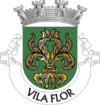Vila Flor
| Vila Flor | |||
|---|---|---|---|
| Municipality | |||

The central square of Vila Flor
|
|||
|
|||
 |
|||
| Coordinates: 41°18′33″N 7°9′14″W / 41.30917°N 7.15389°WCoordinates: 41°18′33″N 7°9′14″W / 41.30917°N 7.15389°W | |||
| Country |
|
||
| Region | Norte | ||
| Subregion | Douro | ||
| Intermunic. comm. | Terras de Trás-os-Montes | ||
| District | Bragança | ||
| Parishes | 14 | ||
| Government | |||
| • President | Artur Guilherme Gonçalves Vaz Pimentel (PS) | ||
| Area | |||
| • Total | 265.81 km2 (102.63 sq mi) | ||
| Population (2011) | |||
| • Total | 6,697 | ||
| • Density | 25/km2 (65/sq mi) | ||
| Time zone | WET/WEST (UTC+0/+1) | ||
| Postal code | 5360 | ||
| Area code | 278 | ||
| Website | http://www.cm-vilaflor.pt | ||
Vila Flor (Portuguese pronunciation: [ˈvilɐ ˈfloɾ]) is a municipality in Portugal. Locally referred to as the Portuguese Capital of Olive Oil, Vila Flor is located in the Terra Quente Transmontana, in the southern part of the district of Bragança. The population in 2011 was 6,697, in an area of 265.81 square kilometres (102.63 sq mi).
It was King Denis who, while travelling through the burg (then known as Póvoa d´Álem Sabor, became enchanted by the local landscape and, in 1286, renamed the district Vila Flor. Around 1295, the King ordered the construction of a walled city, consisting of five gates, to protect the fledgling settlement and guard Portuguese interests in the territory.
During the Middle Ages, this bouquet of flowers, as Cabral Adão once called it, became the home to many fleeing Jewish families, who settled in the territory to start farms, businesses of small industry (such as tanneries and jewelers). King Manuel eventually conferred on the settlement an official charter (foral), later to be reformulated in May 1512. An anti-Jewish, Manuel expelled the Jews from the municipality, whose remaining populous or army were then responsible for destroying the remaining homes.
Administratively, the municipality is divided into 14 civil parishes (freguesias):
Rich in history, tradition, monuments and citizenry, the municipality is also an important reference for agriculture, owing to the fertility of the Vale da Vilariça. Companies, such as Frize and Sousacamp, known within and outside of Portugal, are located in within its frontiers.
The growth of tourism has meant that lodgings have developed throughout the region, including hotels, establishments catering to rural- and agro-tourism. This includes the seasonal treks in the region to the municipalities camping site.
...
Wikipedia


